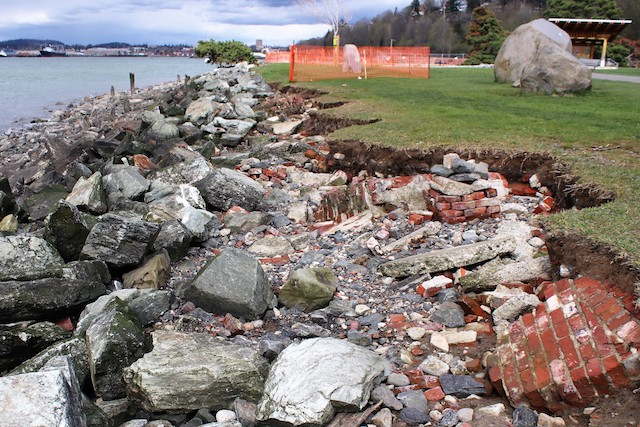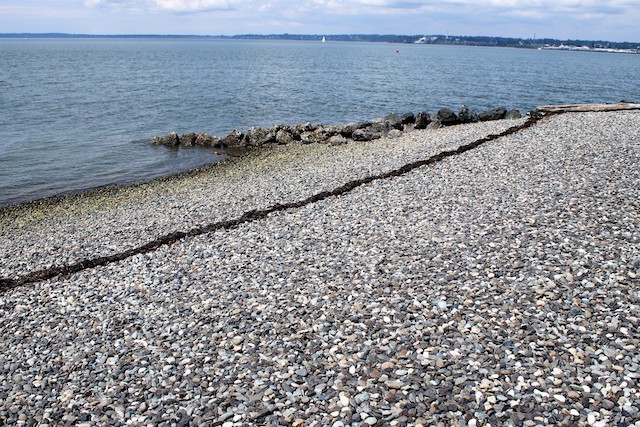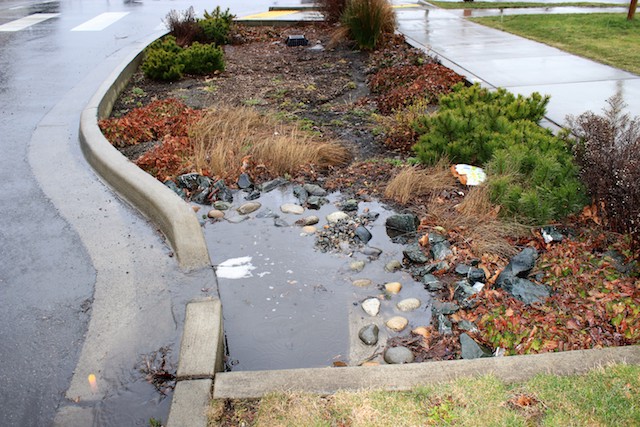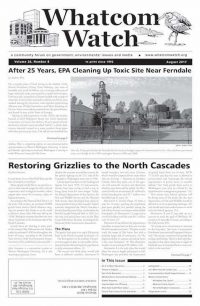by Ron Kleinknecht
Part 2
Editor’s Note: Part 1 appeared on the front page of the Whatcom Watch June 2017 issue.
In Part 1, (1) I made the case that eelgrass (Zostera marina) and other sea grasses are critical to local estuaries and near shore areas as well as to the health of the planet in terms of the many ecological functions they serve. Numerous sea animals live and feed in these beds such as sea stars, crab, salmon, herring, herons, gulls and ducks. I also noted that our local eelgrasses in Puget Sound are holding their own, over all, but eelgrass in general is among the world’s most threatened ecosystems.
Disease and Pollutants
Various natural causes are known to contribute significantly to eelgrass decline, such as the disease that decimated much of the eelgrass on both sides of the North Atlantic Ocean in the 1930s. Fortunately, there has been significant but far from total recovery.
In more recent times, the major threat to eelgrass beds, including Puget Sound, according to experts, is from human activity. (2)
“The majority of Puget Sound’s pollution comes from rainwater runoff from impervious surfaces such as streets, driveways, lawns, and rooftops! In fact, 14 million pounds of toxins enter Puget Sound each year.” (2)
The pollution comes from many sources, including petroleum-based roof shingles, and we have all seen oil sheens in parking lots and driveways. Runoff from these sources eventually finds its way into storm water outlets that drain into creeks, estuaries and bays.
Likewise, industrial pollutants released intentionally or accidently into streams leading to the sound are significant contributors. Take for example the recent Seattle sewage treatment plant release of 260 million gallons of untreated sewage into Puget Sound. (3) More recently the Bellingham sewage treatment plant had an unintended release into Bellingham Bay. (4)
Related pollution contributors include on-the-water sources such as marine fuel spillage, bilge flushing and sewage discharged directly into the sound by both commercial and recreational boats. It is currently legal to flush untreated sewage directly into the sound if at least three miles from shore. This problem is currently being addressed by the state, which is working toward designating the entire sound as a “no bilge discharge zone.” (5) However, commercial boaters are calling foul and have alerted the “new” Environmental Protection Agency (EPA) which is looking into stopping this state effort to reduce Puget Sound pollution. (6)
Toxic runoff also originates from yard fertilizers and manure that seep into rivers and creeks that drain to the saltwater estuaries and affect eelgrass. This nitrogen based runoff stimulates algae blooms when it reaches coastal waters. These blooms “muddy” the water and block sunlight, thereby inhibiting photosynthesis and reducing eelgrass health and leaving it more susceptible to disease. These fertilizer products also support the growth of other nuisance sea vegetation. Added to this fertilizer effect is warming water that facilitates algae growth and speeds up eelgrass respiration. This increased metabolism causes the grasses to use oxygen at a rate faster than it can photosynthesize, which in turn stresses the plant. (7)
Solutions to Pollution:
Since many of the pollution sources are from human activities, they can be ameliorated by changing our behaviors. Hundreds of programs are actively addressing the inadvertent runoff sources of pollution that adversely affect eelgrass and other critical components of the Sound and the Salish Sea. These efforts are being coordinated by The Puget Sound Partnership. (8) The Puget Sound Partnership is a State agency that partners with local, tribal, state, and federal governments, non-profits, environmental groups, academic institutions and hundreds of volunteers dedicated to action to preserve and restore Puget Sound to its former levels of health and productivity. Similar groups are organized around the country that partner with the National Oceanic and Atmospheric Administration (NOAA) and EPA to direct regional efforts. (9)
Although some of the projects are difficult and expensive, many solutions are low tech and can be accomplished by residents understanding the consequences of and being diligent about actions in their own yards.
Sewage treatment plants, when running properly, do a fine job of purifying our storm and sewage. However, it is clear that continued upgrading and surveillance of infrastructure is essential to prevent pollution problems. This type of pollution also contributed to shellfish harvesting closures, both recreational and commercial. And those not on municipal sewage systems must insure that they have properly functioning septic tanks.
A more difficult problem is the seepage of animal waste from farms, largely into the Nooksack River, which runs into Bellingham Bay affecting shellfish and other sea life in Portage Bay. This is being addressed by the Lummi Nation and a group of Whatcom County dairy farmers, who have formed the Portage Bay Partnership to clean up the pollution and to restore the bay. This is a very positive and encouraging development addressing a long standing and serious problem. (10) The best solution is awaited by all concerned. (11)
Efforts such as this partnership are consistent with the goals of the Puget Sound Partnership which hopes to address this runoff problem in relation to eelgrass recovery throughout the sound. Their goal is to reduce nitrogen pollution and achieve a 20 percent increase in eelgrass by 2020. (8)
Other less costly and lower tech solutions to urban runoff can go a long way to reducing this form of pollution. One such simple solution is the planting of rain gardens. As I noted previously, the majority of polluting waters come from runoff from homes, parking lots, industries and streets. Rain gardens are strategically placed gardens along streets and by roof down spouts. They are designed to work like a forest floor or a riparian strip along a stream — they absorb and filter a large amount of pollutants accumulated in rain water before it runs into creeks and rivers.
Stewardship Partners is a cooperative group working with the Washington State University Extension Service that is leading this effort. It is sponsoring a campaign to have 12,000 rain gardens built in the Puget Sound watershed. Although they haven’t met their goal of 12,000 yet, they are making good headway. There are well over 230 rain gardens documented in Whatcom County and more being built all the time. (2) Many of these rain gardens are in private yards and others are adjacent to public streets where the gas and oil runoff are the worst. As the Bellingham Public Works revamps our streets and sidewalks, they install rain gardens along the way to handle the street runoff, and some have been installed along the newly refinished Holly Street in downtown. Nearby residents must agree to help maintain the gardens. (12).
You can check out the rain garden map at this website to see where there are rain gardens near you. (2)
The Stewardship Partners provide lots of assistance to people wanting to build their own rain garden through periodic workshops and a handbook is available online with full details of how to construct one. (13)

Armoring with fill of concrete slabs and old bricks does not prevent erosion — Boulevard Park, Bellingham. This spot also has some toxic substances in it but it will be cleaned up, regraded and de-armored. photo: Ron Kleinknecht
Shoreline Armoring
Another significant source of harm to eelgrass beds and the ecosystem that they nourish is “shoreline armoring.” Home owners, municipalities and industries often build barriers and bulkheads on their shoreline properties to keep sea water at bay and to prevent erosion. Built with the best of intentions, these barriers often inadvertently cause harm to beaches and the near shore marine ecology.
University of Washington scientists recently published a study on the effects of armoring on the Puget Sound shoreline in the journal, Estuarine, Coastal and Shelf Science. They concluded that:
“…armoring was consistently associated with reductions in beach width, riparian vegetation, numbers of accumulated logs, and amounts and types of beach wrack and associated invertebrates.” (14)
Beach wrack is the residue of sea grasses, largely eelgrass that washes up on the beach after large tides and storms. The more robust the eelgrass beds, the greater the beach wrack. The scope of the armoring problem in Puget Sound is underscored by the fact that there are currently more than 700 miles of “armored sea walls,” totaling nearly 30 percent of the Puget Sound shoreline (15) and longer than the coastal shorelines of Washington and Oregon.
Armoring is often accomplished by dumping large rocks, rip rap and other fill materials along the shoreline. Many areas of Whatcom County and Bellingham Bay have been so armored. Boulevard Park and Marine Park in Bellingham were thus armored back in the 1970s. Today erosion has begun to take back some of the area that is now park.
Fortunately, the city has begun to restructure these shorelines by creating more natural beaches that will actually prevent erosion and support the near shore eelgrass meadows.

A restructured beach at Marine Park in Bellingham. Note the long, gradual slope, the groin projecting into the water and the line of beach wrack from the eelgrass meadow just offshore. photo: Ron Keinknecht
De-armoring and Soft Armoring the Shoreline
To reverse these damaging effects of armoring, one could just de-armor them. Given the huge scope of the problem, it is no small issue to confront as a significant portion of armored seawalls throughout the Sound are unlikely to change. Many include large industrial sites, shipping terminals and large civic marinas which are home to and support major recreational and economic activities of the state. But some things are being done to make it all more sustainable. The State has a de-armoring program which works with beach owners to restructure their beaches to align them more with conservation goals. (15)
After de-armoring a beach the first task is to construct a wide, gradually sloped beach. Then groins (groynes) are added which are rigid structures, often large rocks or anchored logs, running perpendicular to the beach. These more natural additions, sometimes called “soft armoring” break up water flow along a beach and preserve sand and small pebbles while inhibiting erosion. And the beach becomes more user friendly. Good examples of de-armoring and soft armoring are seen at Boulevard Park and Fairhaven Marine Park.
Direct Disruption of Eelgrass Beds
Other more direct intrusions into eelgrass beds include building docks in front of waterfront homes, pleasure boats dropping anchors and chains (rodes) into eelgrass meadows and dredging sea bottoms to allow larger boats to enter waterways. Each of these contributes to the degradation of the near shore ecosystem of plant and animal life. Some of these problems can be mitigated by being aware of where eelgrass beds grow and, for example, anchoring out a ways further. Port Townsend had developed just such a program for visiting boasters in which they demarcate the eelgrass boundaries and ask the boaters to anchor beyond the marked area. (16)
Over-water walkways and fishing piers built along the shores and parks are quite popular and provide excellent recreational opportunities for citizens to enjoy the salt water environment. However, they often intrude into eelgrass beds within the intertidal zone. When built over eelgrass beds and not constructed properly, they can restrict the amount of sunlight reaching the eelgrass, which affects its ability to photosynthesize, restricts its growth and ability to sequester carbon and generate oxygen. However, in Boulevard Park, perforated walkway materials was installed to let sunlight through.
Prospects for the Future
While writing this I worried that by the time it comes out there wouldn’t even be an EPA and a NOAA to support the current restoration programs. The President’s current budget proposal cuts Puget Sound EPA budget by 93 percent from its current $28 million to $2 million dollars. (17) NOAA would not fare as badly but stands to lose 22 percent of its budget. (18)
The proposal specifically targets many of the EPA programs that partner with our state and local projects currently underway, including shoreline de-armoring. If these cuts, or any significant fraction of them are implemented, the local effects would be devastating. This is nothing less than an all-out assault on the environment and those who value it, all in the service of reduced regulation on clean air and water.
Although much of the conservation work comes from these agencies, and they are currently doing a great deal, there is much more going on than just in the United States. Significant efforts are underway worldwide to maintain current seagrasses and restore those areas where significant loss has already occurred. Coordinating much of the international effort is the Blue Carbon Initiative working to mitigate climate change through the restoration and sustainable use of coastal and marine ecosystems, including mangroves, tidal marshes and seagrasses. (19) This initiative brings together governments, research institutions, non-governmental organizations and communities from around the world including the United Nations’ IOC-UNESCO. Locally we might have to tag on to these efforts along with other third-world countries.
Were it not for our current administration’s attempt to gut the EPA and NOAA, I would be optimistic about our environmental future. (20) I believe that we can conserve and restore our environment, including our eelgrass, if given support. We all need to get out and fight for what is left of it. It’s coming down to us doing what we can locally.
References
1. Kleinknecht, R. Whatcom Watch, vol. 26, no. 7, June 2017. http://whatcomwatch.org/index.php/article/eelgrass-meadows-our-tidelands-nursery/
2. http://map.12000raingardens.org/place/4608
4. http://www.bellinghamherald.com/news/local/article150295047.html
5. Loomis, L., Whatcom Watch, vol.26, no. 4, April 2017. http://whatcomwatch.org/index.php/article/we-need-to-do-more-to-clean-puget-sound/
7. https://www.eopugetsound.org/articles/nitrogen-eelgrass-stressor-puget-sound
8. http://www.psp.wa.gov/sos.php
9. http://www.habitat.noaa.gov/restoration/connection/partnerships.html
10. http://www.bellinghamhreald.com/news/local/article124868514.html
11. http://whatcomwatch.org/index.php/article/our-environmental-future-depends-on-viable-local-farms/
12. https://www.cob.org/services/environment/stormwater/Pages/dig-raingarden-project.aspx
13. https://fortress.wa.gov/ecy/publications/publications/1310027.pdf
14. http://www.sciencedirect.com/science/article/pii/S0272771416301007
15. https://www.eopugetsound.org/magazine/fix-beaches
16. http://www.jeffersonmrc.org/projects/voluntary-no-anchor-zones/
17. http://www.seattletimes.com/seattle-news/environment/puget-sound-would-be-hurt-by-proposed-epa-cuts/
18. http://www.sciencemag.org/news/2017/05/what-s-trump-s-2018-budget-request-science
19. http://thebluecarboninitiative.org/
20. http://www.psp.wa.gov/2017-day-on-the-hill.php
______________________________
Ron Kleinknecht is professor emeritus of psychology and dean emeritus of Western Washington University’s College of Humanities and Social Sciences. He is a life-long nature and conservation enthusiast who writes about the Pacific Northwest.





























